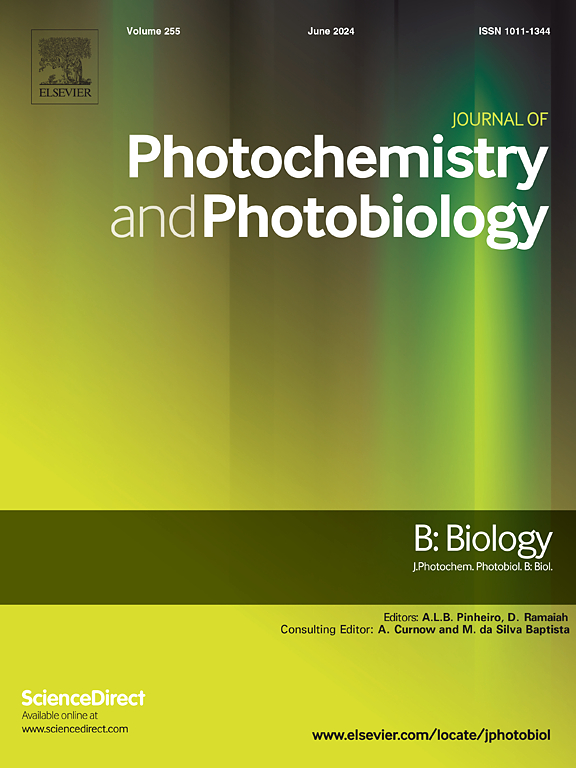生物合成,表征,和多方面的应用合成银和金纳米粒子:抗癌,抗菌,杀幼虫,和光催化活性。
IF 3.7
2区 生物学
Q2 BIOCHEMISTRY & MOLECULAR BIOLOGY
Journal of photochemistry and photobiology. B, Biology
Pub Date : 2025-02-01
DOI:10.1016/j.jphotobiol.2025.113102
引用次数: 0
摘要
利用植物提取物绿色合成金属纳米颗粒已成为传统方法的环保替代品,在生物医学和环境修复方面具有潜在的应用前景。本研究以大戟叶提取物为还原剂和封盖剂,成功地合成了纳米银和纳米金。利用UV-Vis光谱、HR-SEM、EDX、TEM、AFM、XRD和FTIR分析对纳米颗粒进行了全面表征,证实了它们的成功合成,并揭示了它们的主要球形形态,尺寸从1到100 nm不等。SNPs和GNPs对MCF-7乳腺癌细胞具有显著的抗肿瘤活性,IC50值分别为59.87 μg/mL和91.074 μg/mL。碘化丙啶染色、DAPI染色和彗星实验证明,纳米颗粒可诱导癌细胞凋亡和DNA损伤。在抗菌研究中,与GNPs相比,SNPs对大肠杆菌(17.00 mm抑制区)和金黄色葡萄球菌(10.77 mm抑制区)均表现出更强的活性。该纳米颗粒对埃及伊蚊也显示出良好的杀幼虫活性,snp的LC50为20.81 mg/L,高于GNPs的51.10 mg/L。组织病理学分析显示,snp处理的幼虫有明显的组织损伤,特别是在中肠、后肠、肌肉和神经节。此外,两种纳米粒子都表现出降解亚甲基蓝染料的光催化活性,其中单核苷酸多态性表现出优异的性能。这些发现表明,利用黄芽孢杆菌合成的生物功能化snp和GNPs具有多种生物学应用价值,具有广泛的生物医学和环境应用前景。本文章由计算机程序翻译,如有差异,请以英文原文为准。
Biosynthesis, characterization, and multifaceted applications of Elytraria acaulis synthesized silver and gold nanoparticles: Anticancer, antibacterial, larvicidal, and photocatalytic activities.
Green synthesis of metal nanoparticles using plant extracts has emerged as an eco-friendly alternative to conventional methods, offering potential applications in biomedicine and environmental remediation. This study demonstrates the successful biosynthesis of silver nanoparticles (SNPs) and gold nanoparticles (GNPs) using Euphorbia acaulis leaf extract as a reducing and capping agent. The nanoparticles were thoroughly characterized using UV–Vis spectroscopy, HR-SEM, EDX, TEM, AFM, XRD, and FTIR analyses, confirming their successful synthesis and revealing their predominantly spherical morphology with sizes ranging from 1 to 100 nm. SNPs and GNPs exhibited significant anticancer activity against MCF-7 breast cancer cells, with IC50 values of 59.87 μg/mL and 91.074 μg/mL, respectively. The nanoparticles induce apoptosis and DNA damage in cancer cells, as evidenced by propidium iodide staining, DAPI staining, and comet assay. In antibacterial studies, SNPs demonstrated superior activity against both E. coli (17.00 mm zone of inhibition) and S. aureus (10.77 mm zone of inhibition) compared to GNPs. The nanoparticles also showed promising larvicidal activity against Aedes aegypti, with SNPs exhibiting higher potency (LC50: 20.81 mg/L) than GNPs (LC50: 51.10 mg/L). Histopathological analysis revealed significant tissue damage in SNP-treated larvae, particularly in the midgut, hindgut, muscles, and nerve ganglia. Additionally, both nanoparticles demonstrated photocatalytic activity in degrading methylene blue dye, with SNPs showing superior performance. These findings suggest that biofunctionalized SNPs and GNPs synthesized using E. acaulis possess multiple biological applications, making them promising candidates for various biomedical and environmental applications.
求助全文
通过发布文献求助,成功后即可免费获取论文全文。
去求助
来源期刊
CiteScore
12.10
自引率
1.90%
发文量
161
审稿时长
37 days
期刊介绍:
The Journal of Photochemistry and Photobiology B: Biology provides a forum for the publication of papers relating to the various aspects of photobiology, as well as a means for communication in this multidisciplinary field.
The scope includes:
- Bioluminescence
- Chronobiology
- DNA repair
- Environmental photobiology
- Nanotechnology in photobiology
- Photocarcinogenesis
- Photochemistry of biomolecules
- Photodynamic therapy
- Photomedicine
- Photomorphogenesis
- Photomovement
- Photoreception
- Photosensitization
- Photosynthesis
- Phototechnology
- Spectroscopy of biological systems
- UV and visible radiation effects and vision.

 求助内容:
求助内容: 应助结果提醒方式:
应助结果提醒方式:


